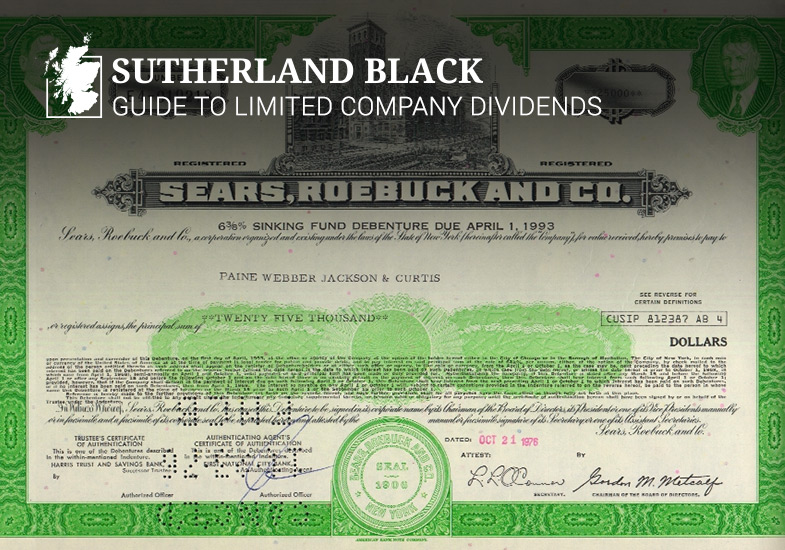Updated 13/2/2025 and current at the time of writing.
Many small businesses in the UK are set up as Limited Companies. There are many benefits to this approach and some legal and accounting concepts that owners need to understand. A Limited Company is a separate legal entity to the owners. As such, the money in the company’s bank account does not directly belong to them. Dividends are one of the ways that owners can extract profits from the business. Many limited company owners structure their remuneration as salary and dividends to reduce their overall tax liability.
Dividends are paid from the post-tax profit of a Limited Company to the shareholders of a business. For a small business owner, dividends can be a great way of saving national insurance and can be a tax-efficient way of remunerating themselves.
To be a legal dividend, there must be enough post corporation tax reserves to cover the payments. The dividends need to be paid according to the classes of shares that exist in the company.
Consideration also needs to be taken about the income tax that the recipients will pay on these dividends. The timing of the dividends for the company and the individual can also affect the tax outcome.
Read on to learn more about the practical aspects of declaring dividends and the tax on dividends. We will also suggest some exciting ways of structuring your limited company to make the company tax efficient for you and your family.
What is a Limited Company Dividend?
A limited company dividend is a payment to a company’s shareholders from the company’s distributable profits. In plain English, after the company has paid corporation tax on its earnings, it can transfer the leftover money to the shareholders. In a typical small UK limited company, the shareholders are often the limited company directors. It is important to note that dividends are paid to shareholders, not company directors.
Company shares are a complex legal subject. Most small limited companies will have a simple structure with a number (typically 100) of shares, all of which are the same type (or class). For some great information about different types of shares and reasonably priced legal templates, see here.
How to issue a dividend
The best way to explain how to issue a dividend is an example. A business with sales of £500,000 and costs of £400,000 has a profit of £100,000. The corporation tax is 25% at the moment, however after the reintroduction of Marginal Relief the rate for small Companies can be as low as 19%. You can find an HMRC calculator here . For profits of £100,00 the actual tax will be £22,750 or 22.75%. This means £77,250 remains available for distribution.
The company can pay dividends during their financial year as an “interim dividend” or after the year-end as a “final dividend.” In either case, the Directors must satisfy themselves that there are enough distributable profits to issue the dividend. Distributable profits are carried forward in the accounts, so a dividend does not have to be issued out of the current year’s profits.
Continuing the example from above, if there are two equal shareholders with 50 shares each, the company will issue a dividend of £772.50 per share, resulting in a payment of £38,625 each. A dividend certificate should be issued, which is a legal document, not an accounting document, and should include:
- The Name of the company
- Company registration number
- Date of issue
- Name and address of shareholder receiving the dividend
- Share class
- Amount of the dividend payment
- Signature of authorising officer (usually a director).
Timing a Limited Company Dividend
The timing of the dividend payments can be significant. The company year and the personal tax year will probably be different. For example, suppose a company has a year-end of 30th June 2024, and a dividend is declared on the last day of the company year.
In that case, the dividend will go into the personal year 24/25, and the personal dividend tax would be payable by the 31st January 2026. However, if an interim dividend were declared on the 30th March 2024, the dividend would go into the 23/24 tax year. The dividend tax would be payable by 31st January 2025.
Accounting for a dividend
When you declare a dividend, the accounting entries should be processed in your bookkeeping software. Most bookkeeping packages such as Xero have a dividend nominal ledger to record the reduction in the retained profits.
So you would debit this account and typically credit the director’s loan account relevant to the dividend declaration. Then as the director draws down the money, you would debit the director’s loan account and credit the bank to show the payment.
Tax on dividends
There is no tax consequence for a company in declaring a dividend. When an individual receives a dividend, the company has already paid tax on the profits that allowed the dividend to be paid. Your accountants will enter the dividends on the self-assessment tax return for the recipient. The recipient will pay income tax, the amount of which depends on the other income that the individual receives.
Each individual receives a tax-free dividend allowance of £1,000, so it is a great idea to declare this amount of dividends as a minimum each year for each shareholder. This allowance is on top of the person’s personal allowance and will be free of income tax.
Even though Scotland has different income tax rates from England, the dividend tax rates are the same. The rates that dividends are taxed are as follows depending on which tax band the dividends fall:
- Basic Rate: 8.75%
- Higher Rate: 33.75%
- Additional Rate: 39.35%
How dividends can save you tax
The primary way dividends save tax for owner-managers is that there are no employee or employer national insurance contributions on dividends which can mean a massive tax saving. In the example above, each shareholder (assuming they were also working for the company) could pay themselves a £45,000 salary. This would cost the company roughly £10,000 in employers national insurance contributions.
Each person would then receive £35,477 in Scotland after income tax and national insurance. This will reduce after Employers NI increases in April 25.
If they paid themselves just in dividends, they would receive a £38,625 dividend and would receive approximately £36,432 after dividend tax. Note that paying just in dividends is not a regular practice. Usually, a small salary is taken along with dividends, as we explain in our guide to salary and dividends in a limited company.
How dividends interact with the director’s loan account
Typically in a small Limited Company, the owners (shareholders) and the directors are the same people. As we have explained, the directors often take a small PAYE salary and dividends to minimise the amount of National Insurance that the company and individual pay. This means dividends should be declared periodically to cover the money (drawings) that the director will take to live on. Suppose more money is taken than the dividends that have been declared. In that case, the director can end up with what is known as an overdrawn director’s loan account.
When a director has an overdrawn loan account, there are two tax effects. As the company is loaning money to the director, then there is a benefit in kind which creates an income tax charge if the loan is over £10,000, and also potentially a corporation tax charge for the company (known as the section 455 charge) if the loan is not repaid by nine months after the company year-end. Full details are here.
Alphabet shares and dividends
Paying dividends to an owner-manager instead of taking a larger salary is a great way to save on tax, but what happens if you want to pay different people different amounts? If a company was owned 50:50, but one co-owner only worked two days a week, and the other full time, this can cause an issue.
When dividends are issued, they must be issued in line with the share rights of the class of shares that the dividend is for. Many companies only have “Ordinary” shares, and thus, in this case, the dividends would have to be equal. A popular arrangement is known as “Alphabet Shares”.
If you have, say, Class A shares and then Class B shares, different dividends could be declared on each; however, this comes with a health warning. HMRC may look dimly at this sort of arrangement as it can then be perceived that these payments are for work done and not ownership. The legality of the dividend payment could be challenged. Clients should take advice before proceeding with this approach.
Splitting dividend income with your spouse to save tax
In 2007 there was a court case, “HMRC vs. Arctic Systems,” where HMRC argued that dividends on shares owned by a spouse of an owner-manager should not be taxed in the same way as usual. It was a complex case with some details here.
HMRC effectively lost the case, which is good news for owners of small limited companies with spouses. If you are married to someone who pays tax at a lower rate than you, splitting the shares can be very tax-effective. Dividends issued to the spouse will be entered into their self-assessment tax return and be taxed separately. If the spouse has no other income, there will be an extra dividend allowance and an extra personal allowance which will mean tax-free income on the first £14,570 of dividends they receive (21/22 tax year). They will then pay a lower dividend tax rate on the rest of the dividends as their basic rate allowance will be used.
This type of tax planning is safe and reliable. The shares should be of the same class. If possible, it is better to start this arrangement when the company is set up to avoid capital gains tax bureaucracy if shares are transferred.
Get In Touch
Company structure, share classes, and Dividend payments are complex subjects. If you would like advice around any of these aspects in your Limited Company, please do not hesitate to get in touch with our accountants in Edinburgh.





